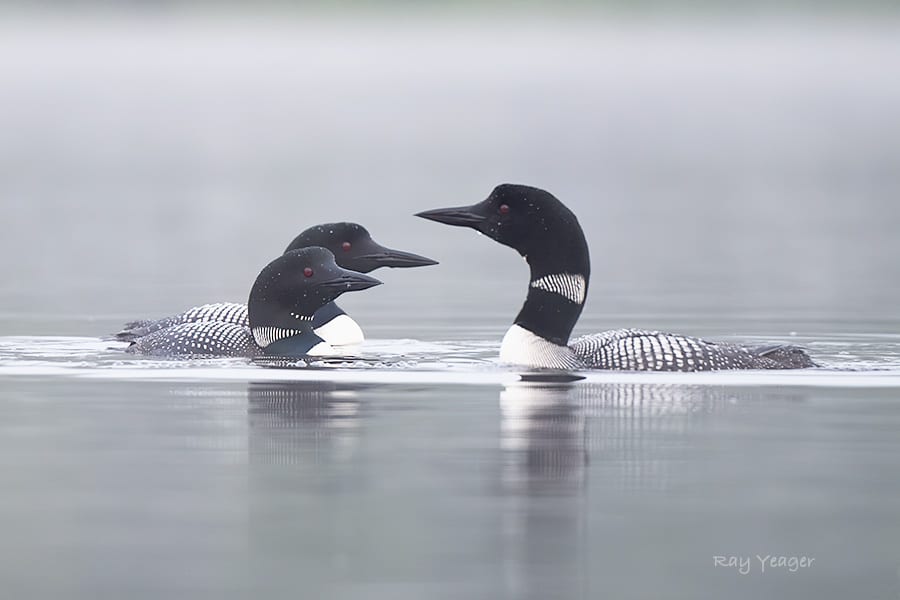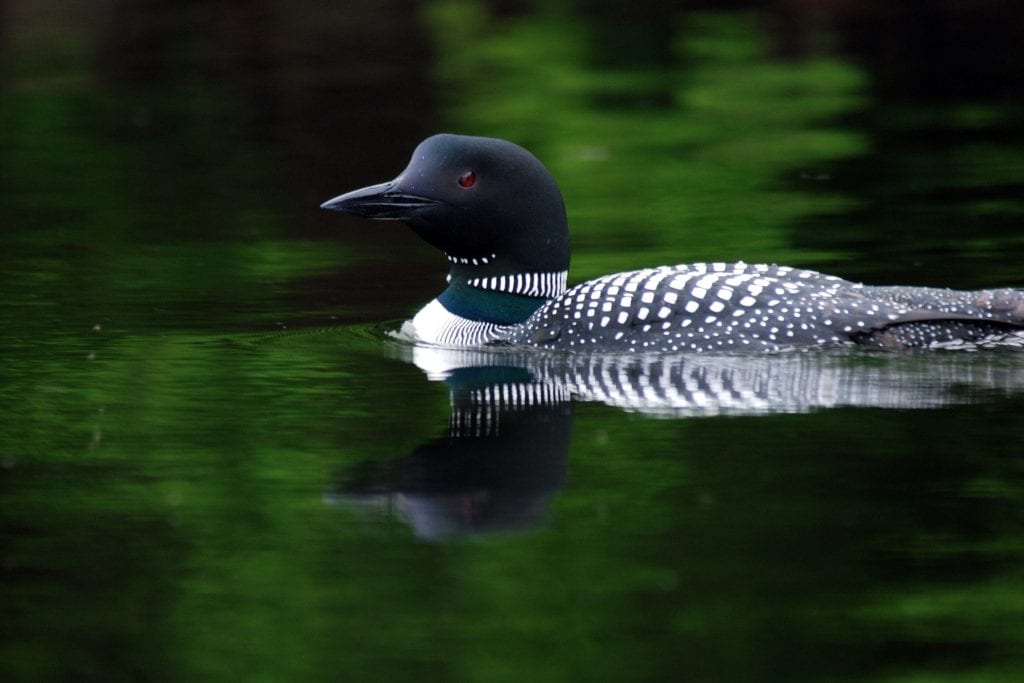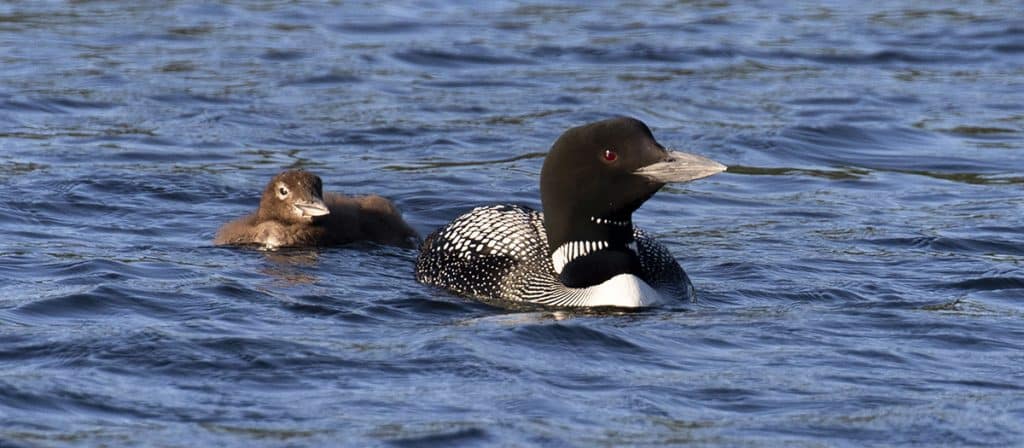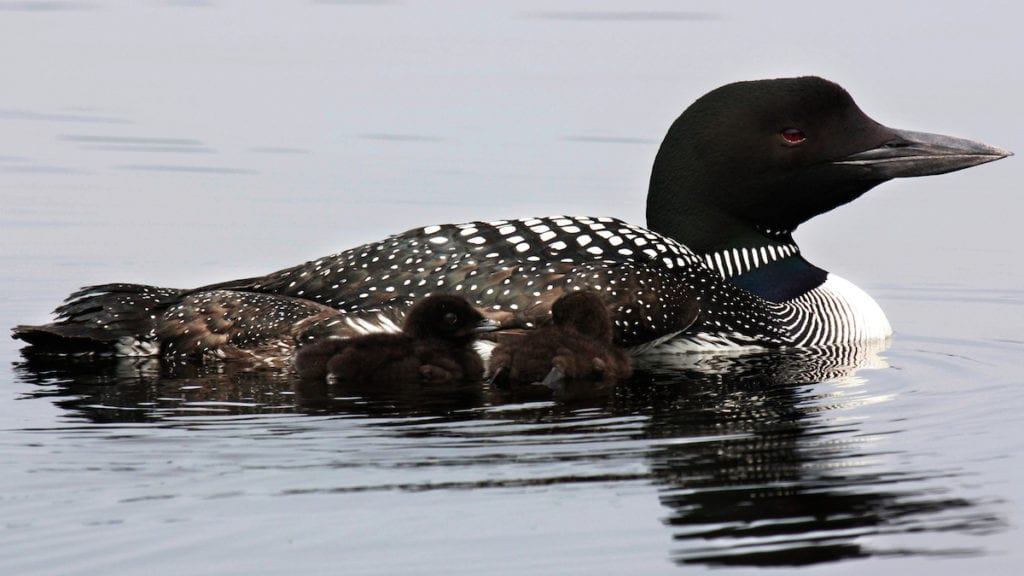
This year marked the thirty-seventh straight year that Maine Audubon has engaged volunteers, early in the morning on the third Saturday of July, to count loons on lakes across the state.
The 2020 Maine Annual Loon Count stands out in this long-running tradition for a few reasons. Falling this year on the 200th day of Maine’s bicentennial, the 2020 loon count was a wonderful way to celebrate a Maine icon and the state’s natural history. With the pandemic, it also provided a way for well over a thousand volunteers to participate outdoors in a socially-distanced community science project and come together–at least metaphorically–to contribute to our understanding of the state’s Common Loon population trends. Volunteers new to the count joined others who had participated last year; there were also some who have been part of the count since its inception over three decades ago.

On July 18, many volunteers woke up to a blanket of dense fog. Thankfully, in many regions, the fog lifted just as the count began at seven a.m., although it stuck around to complicate loon spotting on a number of lakes and ponds. Photographs and excited emails started rolling in almost immediately. (Click here for our recap of the photos, video, Facebook posts, tweets, articles and other excitement from the 2020 Loon Count!)
At the area I was covering on a part of Sebago Lake, the fog lifted just in time for the count, which started with the wail of a single loon spotted a few minutes after 7 a.m. All in all, I counted four adult loons in my section, as well one beaver crossing, one bald eagle, and a large group of Common Mergansers–all while also answering calls and emails about the count from my kayak.

The results of the count are still rolling in. Dedicated regional coordinators and counters are entering their data online on the new loon data portal and sending in their maps and count forms. When all of the data is collected, coordinators will start the vital task of reviewing the data and tallying the totals. From this data, Maine Audubon releases the numbers of adults and chicks counted on each lake and also calculates a population estimate each year for the southern half of the state, which includes the area below the 45th parallel.
While we release running totals for individual lakes and ponds in the northern part of the state, we do not have enough coverage to be able to calculate a full state population estimate at this point–we hope to change that in years to come with the help of volunteers! The results of the count are normally released in December.
Over the last three decades we have seen a positive trend in the state’s loon population and in recent years the population has been holding steady despite a laundry list of threats. We hope for, and tentatively anticipate, count results to be in line with results from recent years with the state’s loon population still thriving.

But as Manager of the Maine Loon Project at Maine Audubon, I do have some concerns about productivity this year, based on anecdotal reports we have been receiving over the course of the season. Some reported that heavy rains raised lake levels by as much as 10 inches early on, which can flood loon nests built right at the shoreline; some nests were reported as abandoned.
We’ve also fielded more concerns this year than last about boats not obeying the state law that prohibits wake-producing speeds within 200′ of shore, and about wake boats, also known as ballast boats or surf boats, that produce much larger wakes. Collisions with boats have been a leading and ongoing cause of death for loon chicks and wakes can and do wash eggs out of nests. These reports are of particular concern, because in recent years data from necropsies (autopsies) on loon carcasses suggest that collisions with boats may be surpassing lead poisoning as the leading cause of adult loon mortality in the state.
It’s good news and bad news: this is likely the result of both an increase in boat strikes (that’s the bad news) and also a decrease in lead poisoning as a result of the state lead tackle ban and community efforts to reduce lead tackle use with the help of the Fish Lead Free Initiative and the new Maine Lead Tackle Buyback Program (that’s the good news).
We’ve also had reports of more loons congregating in groups rather than nesting this year. Predation from bald eagles continues to be documented, and chicks have also been reported to have been killed by non-breeding loons on two lakes this year. Last but not least, consumer fireworks set off near loon nesting areas can cause disturbance to nesting loons, and the calls and emails expressing concerns for loons flooded in around the Fourth of July this year. If parents leave the nest due to disturbance, it can leave the eggs both vulnerable to predators and exposed to the elements.

Once the loon count results are analyzed, we’ll be better able to judge whether these are mostly isolated occurrences or if they are representative of more state-wide trends in productivity or population numbers. As a snapshot of the population, the loon count doesn’t provide a full account of breeding success like full-season monitoring programs, but it does provide an important and consistent snapshot comparison of the population from year to year. The loon count serves to track population trends over time. While the loon population fluctuates from year to year, the loon count can serve as an alarm system should we see consistent or dramatic declines.
The growth in the loon population to date is attributed to a number of things–the no-wake law, the lead tackle ban, and the efforts of loon counters, lake associations, and partners across the state who are taking actions to protect water quality and nesting habitat and getting the word out about what can be done locally to protect loons. Given the current and emerging threats facing loons, continued vigilance and statewide community involvement will continue to be critical in keeping Maine’s loon population thriving.
An enormous thank you to all of our loon count volunteers this year! And if you’ve never been part of the loon count, come join us for next year’s loon count!
